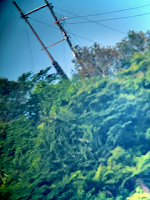— the degree of blue and gray in the sky during the daytime determines the amount of air pollution and upper atmospheric haze —
Left: this Celestron Nexstar (new revised edition) has proved to be splendid optically and a fantastic performer, even through window glass.
The successful telescopic mountain conservation project at Singularity Observatory (HSO) has proven to be spectacular, showing the wide varieties of plant and animal life in the vicinity. The new Celestron Nexstar 6 SE telescope is a spectacular performer with extreme resolution, able to shoot excellent images from indoors through window glass for the ultimate observatory convenience.
Compare the camera view at the top of the page to the view taken through the telescope seen at left with a handheld iPhone shooting at f/10 with the supplied 25mm fl Celestron Plossl eyepiece and eyepiece projection. The image is so spectacular, shot from indoors through window glass, it even shows changes in FOV distances throughout the variable vegetation distances.
The wiring detail on the power pole is remarkable. The photo is taken with the iPhone 10 XS Max smartphone, handheld, 4.25mm ISO25, f/1.8 3024x4032 and a 1/279 second exposure focused on the projected telescope image at 25mm f/10 eyepiece projection. For additional resolution and 2x potentially up to 5x image scale, a negative lens barlow will become the primary optics train giving f20 through f50. This will likely pull in individual vegetation leaves and possible small animals, amphibians, reptiles and birds, provided the good weather trends hold up.


